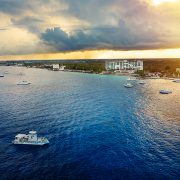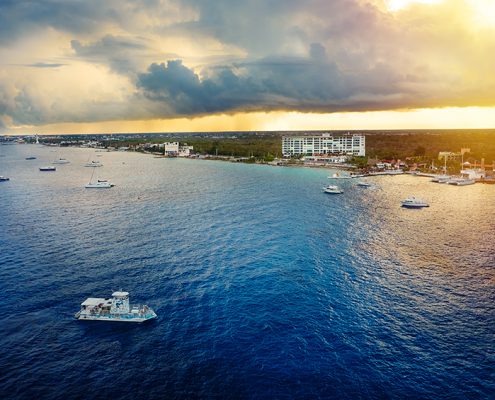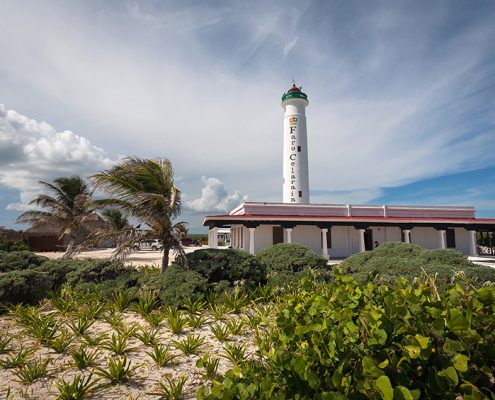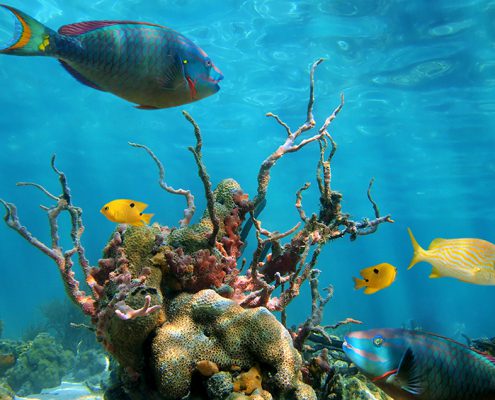More than a thousand years ago, Mayan pilgrims from all over the Yucatan Peninsula would board fragile canoes to make the crossing to the sacred island of Cozumel, defying wind, waves and currents. Their destination was the shrine of Ixchel, the Mayan goddess of the moon and fertility. Nowadays, the crossing to Cozumel takes only minutes from Playa del Carmen and the beautiful island welcomes pilgrims of another sort, visitors in search of spectacular coral reefs and beaches. Why not plan your own Cozumel outing on your next trip to Grand Residences?
Cozumel’s incredible coral kingdom
First brought to international attention by Mexican diver René Cardona and French conservationist and filmmaker Jacques Cousteau, the chain of reefs circling Cozumel’s leeward coast offers some of the finest diving in the world. Visibility is as high as 200 feet and the seascapes are breathtaking: towering coral buttresses festooned with sponges and coral gardens teeming with marine life. Everywhere you look, 300 species of multicolored fish of all shapes and sizes swim serenely by, feed on algae or hide among the corals.
The current enables divers to practice drift diving and literally fly past coral walls and drop-offs, keeping pace with sea turtles and schools of eagle rays.
Divers can literally spend a lifetime exploring reefs like Paraíso, Chankanaab, La Herradura, San Francisco, Yucab, Santa Rosa, Colombia, Maracaibo and the largest of them all, Palancar, famous for its coral buttresses, caves and walls.
There are experiences for every diver, from challenging wall and cave dives for advanced scuba divers to shallow reefs for beginners.
Chankanaab Park, snorkeling paradise
Cozumel’s most famous snorkeling spot has to be Chankanaab Park, a sheltered lagoon behind a pristine coral reef that is home to many colorful fish such as angel fish, blue tangs, jacks and sergeant majors. The park also includes a cenote or sinkhole connected to the Caribbean by an underground river, a botanical garden and a dolphin area.
Another favorite with snorkelers is a boat trip to El Cielo, a shallow reef and calm stretch of crystal-clear water where the seabed is covered with starfish. Take photos but don’t disturb these living treasures.
For visitors who would prefer to see the underwater world without getting wet, there are glass-bottomed boats and an unforgettable immersion on the Atlantis submarine, which dives to a depth of 100 feet.
Exploring San Miguel, the tranquil island capital
Back on dry land, stroll through the quiet streets of the island capital San Miguel. Browse the many craft galleries, boutiques and jewelry stores or cool off with a gelato or cocktail. Dine on fresh fish, shrimp, lobster and the island specialty caracol or conch when it’s in season.
Call in at the Cozumel Museum for a glimpse of the island’s history, traditions and natural heritage. There are exhibits on the ancient Maya and the Spanish expeditionary force led by Hernán Cortés which landed on the island in 1519 and went on to conquer the Aztecs. Other exhibits tell the story of pirates such as Captain Henry Morgan and Miguel Molas who hid on the island, and 19th-century settlers fleeing strife on the mainland during the Caste War.
Other displays showcase island traditions such as the Carnival and the El Cedral Fair held at the beginning of May. The natural history section of the museum allows you to see the coral reefs in all their splendor and learn about the island’s jungle and wetland ecosystems, both of which are rich in wildlife, including endemic creatures such as the pygmy raccoon.
Cozumel is a popular Caribbean port of call for cruise ships and San Miguel can get crowded when several boats dock at once so you may want to time your visit accordingly.
Cozumel’s Mayan heritage
In ancient times, Cozumel or Cuzamil, “land of the swallows,” as it was known was held sacred by the Maya as the site of a shrine to Ixchel, goddess of the moon and fertility. Ancient temples still dot the flat, forested landscape and there are lighthouses and lookout posts on the coast, testimony to the days of Mayan seafarers.
San Gervasio is the largest of Cozumel’s 25 archaeological sites and during the pre-Hispanic period it was a bustling city and a center of maritime trade. It was also visited by pilgrims who would travel hundreds of miles overland and then make the perilous sea crossing from Xaman-Há (Playa del Carmen) and Pole (Xcaret) to worship Ixchel. Other Mayan sites include El Cedral and Caracol.
Wild beauty
Rent a car, moped or taxi and take a tour of the island. Spend the day on one of the sheltered beaches on the west coast of the island. Go bird watching in Punta Sur nature reserve, a chain of lagoons and wetlands on the southern tip of the island. Venture into the jungle or visit Isla de la Pasión in the north.
Cozumel’s rugged east coast has some beautiful, deserted stretches of sand for walking. However, be aware that strong currents and undertow make swimming dangerous on the windward coast.
Getting there
If you would like to visit Cozumel, the Concierge will help you plan an unforgettable excursion, including the ferry crossing from Playa del Carmen, snorkeling or diving, fishing, and other island sightseeing adventures.








